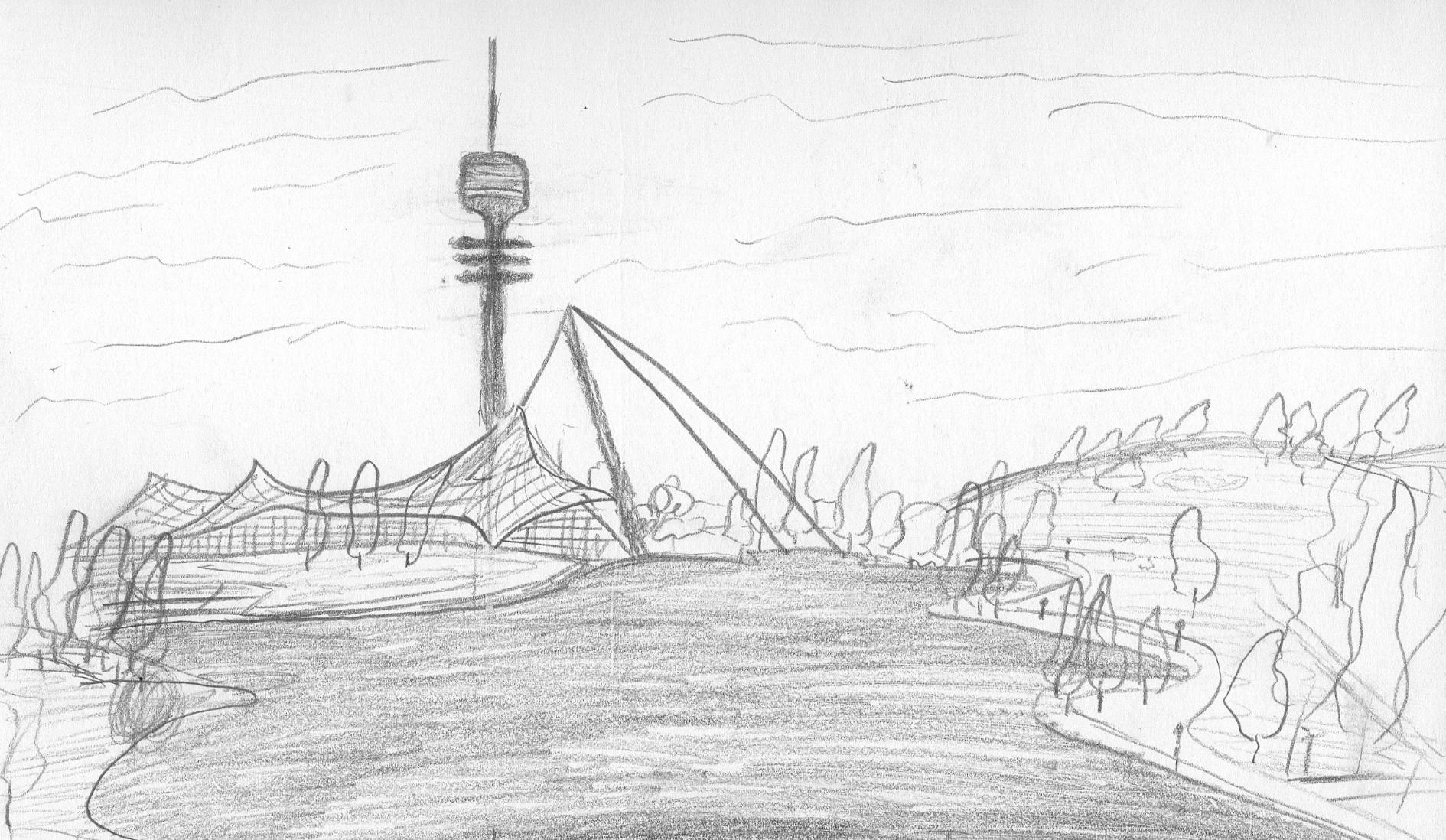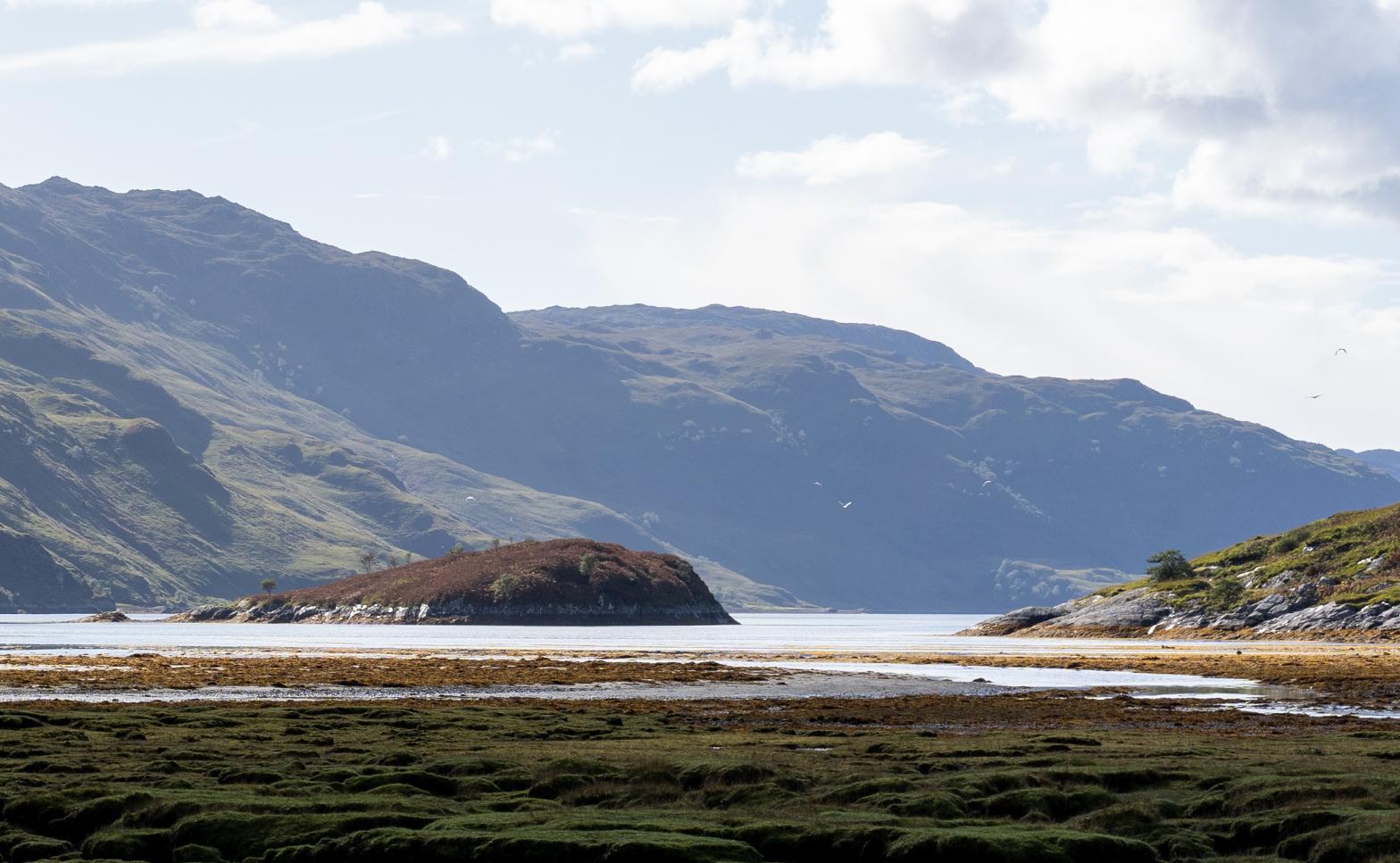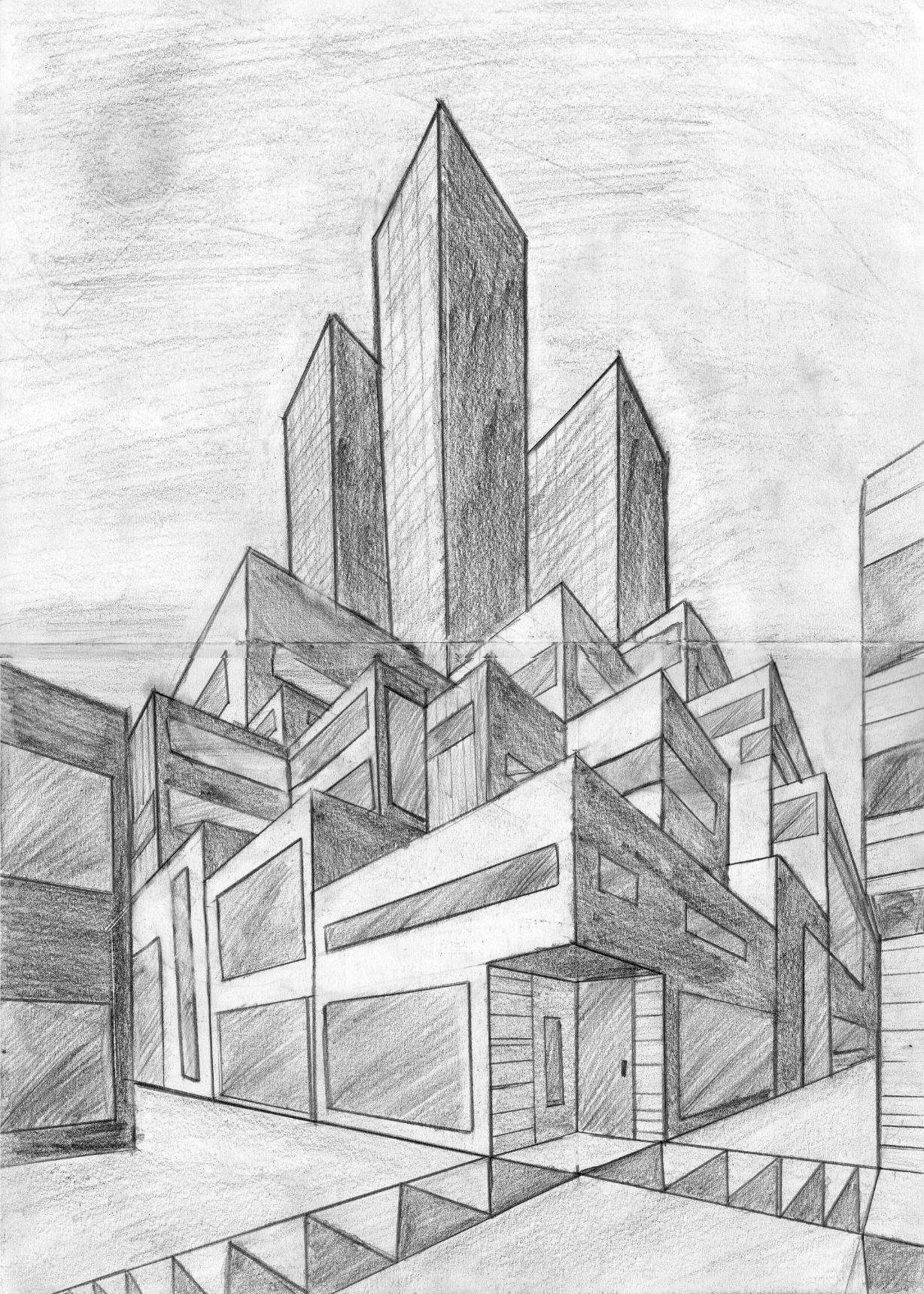Zachary Elliott
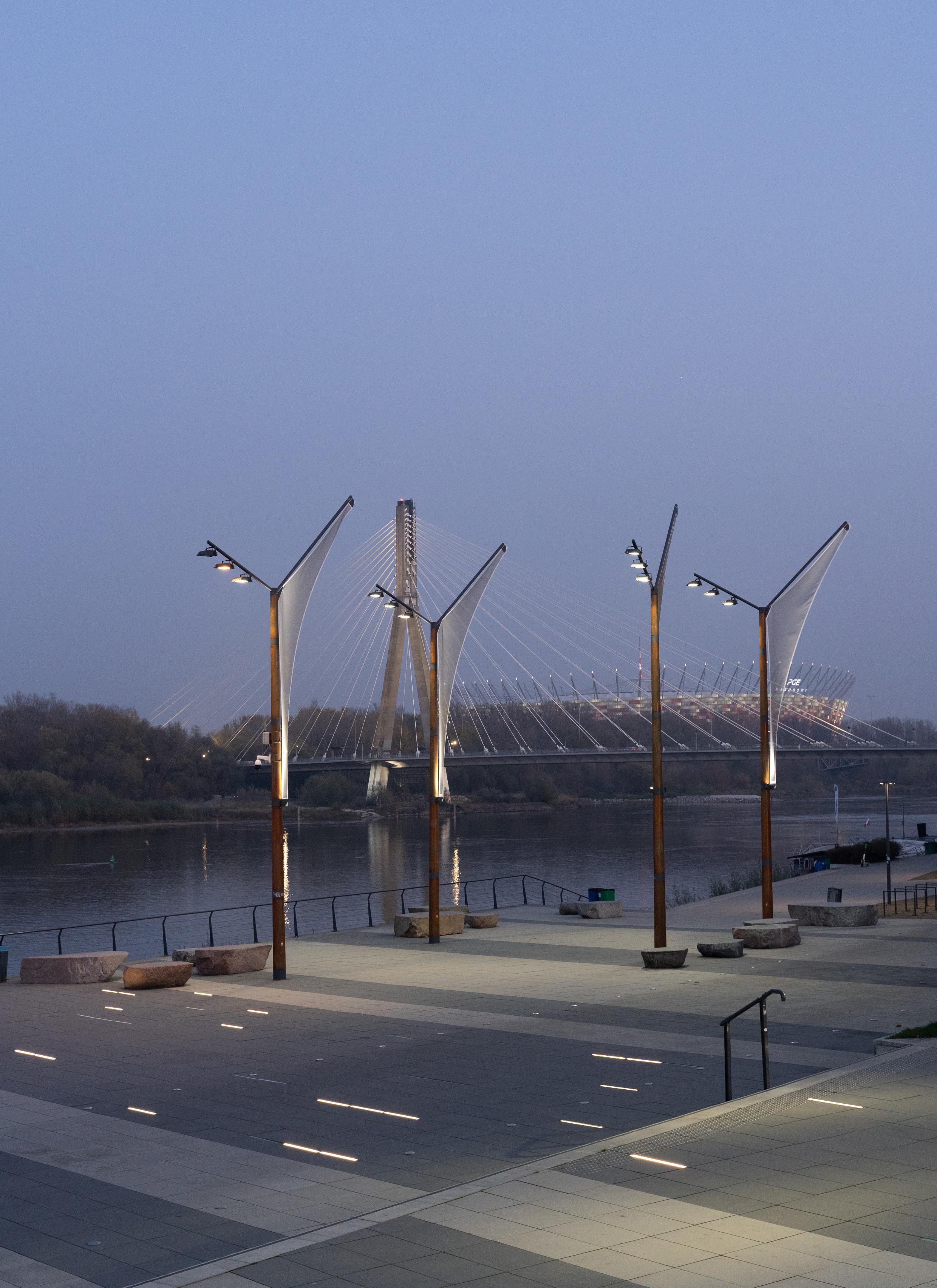

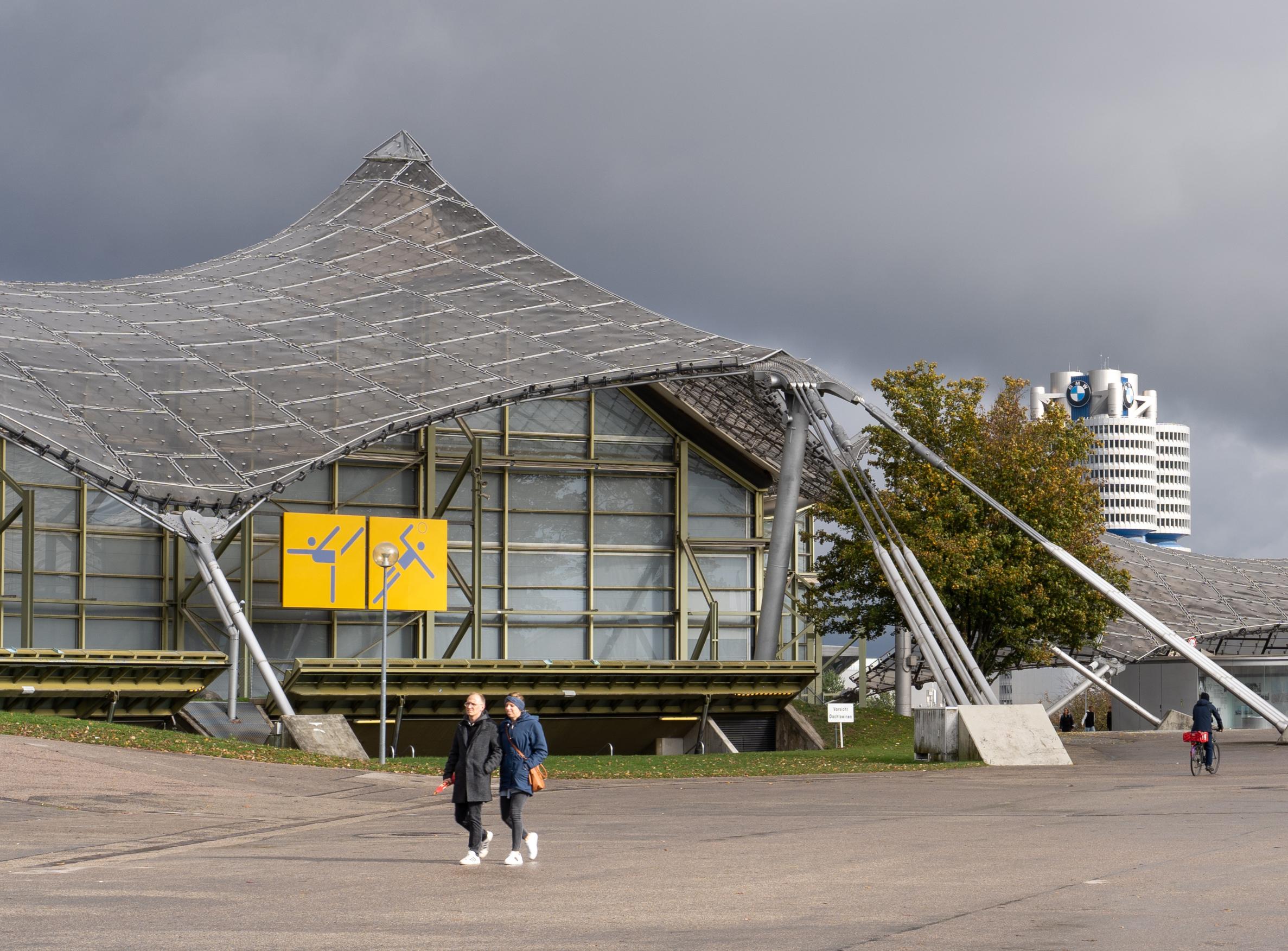
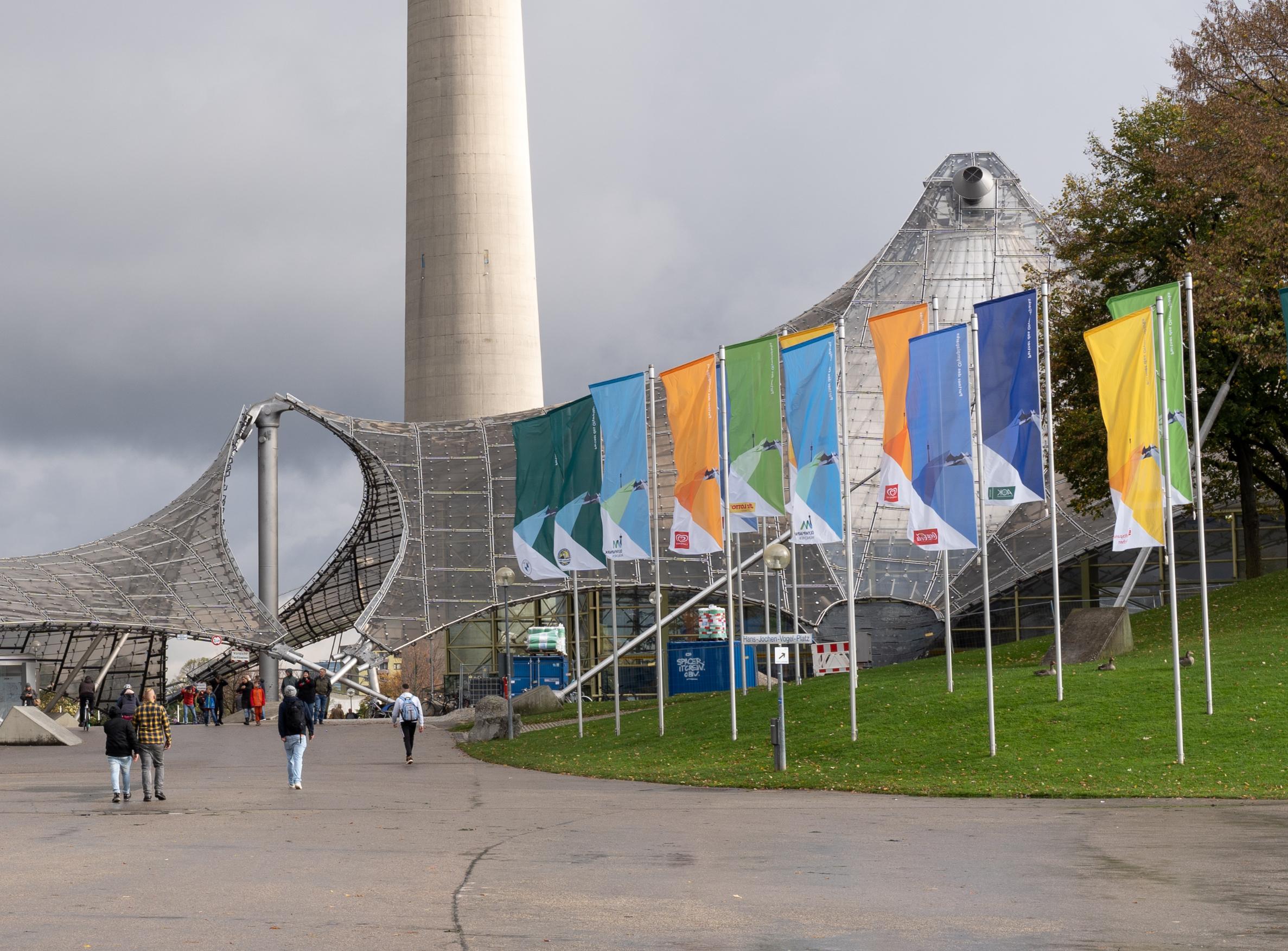





BAGeographyDissertation(2022)
Myundergraduatedissertationexploreshowparkusersencounter andexperiencethedesignedspacesoftheQueenElizabeth OlympicParkinEastLondon.Theparkintegratesrecreational, ecological,andhydrologicalapproachestoriverineparkdesignin awaythatblurstheboundariesbetweencityandpark,natureand culture,landandwater.
Thisprojectbuildsonsixteenconversationswithusersofthe OlympicPark,myownimpressionsoftheOlympicPark’sspaces andvolumes,anddesigntextspublishedaboutthepark.Itexplores howpeopleexperienceandencountertheparkassocio-ecological hybridacrossthreethemes:‘affectiveimpressions’,‘plantingsand habitats’,and‘bythewater’.Thesemapontothethreedesign concernsbroughttogetherbytheriverineparknexusconcept: recreational,ecological,andhydrological.
Conductinginterviewswithparkuserscountersanover-emphasisin existingacademicliteratureondesignintentionsratherthanonhow peopleexperiencehighlydesignedspaces.Itisvitaltoconsider howparkusersencounterandanimatethespacesandvolumesof landscapesliketheOlympicParkbecauseurbanparksare designedforpeople.
ParkusersencountertheOlympicParkasaseriesofmore-than spacesthataredynamic,complex,andlived-inbyhumansand nonhumans.Becausetheparkisahybridlandscapemeltingthe boundariesbetweenhumans/nonhumans,city/nature,andpark/ city,humanandnonhumanworldscollideinthepark’sspacesin delightfulways,deliveringadistinctivesensethatthereis‘more aroundyou’.

Mydissertationdemonstratesthatthedeploymentofrecreational, ecological,andhydrologicaldesignstrategiestoriverineurban parks,inawaythatrideswiththemessinessofcitiesashybridand more-than-human,isnotonlybeneficialforurbanhydrologyand ecology,butcanalsocontributetoenjoyable,intriguing,and restorativeexperiencesforhumanparkusers.
Readthefulldissertationatzacharye.com/encounteringthe-riverine-park-nexus
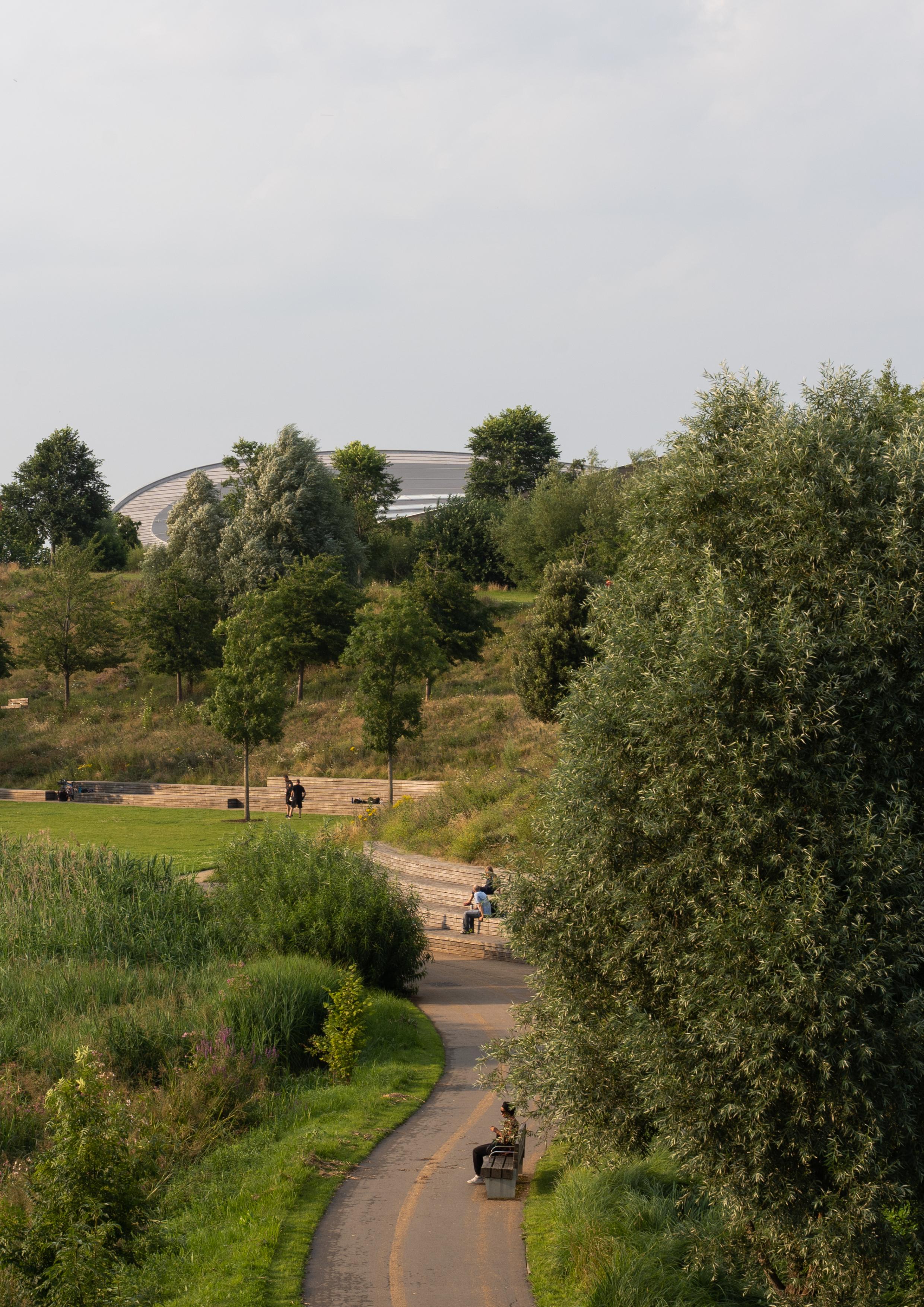
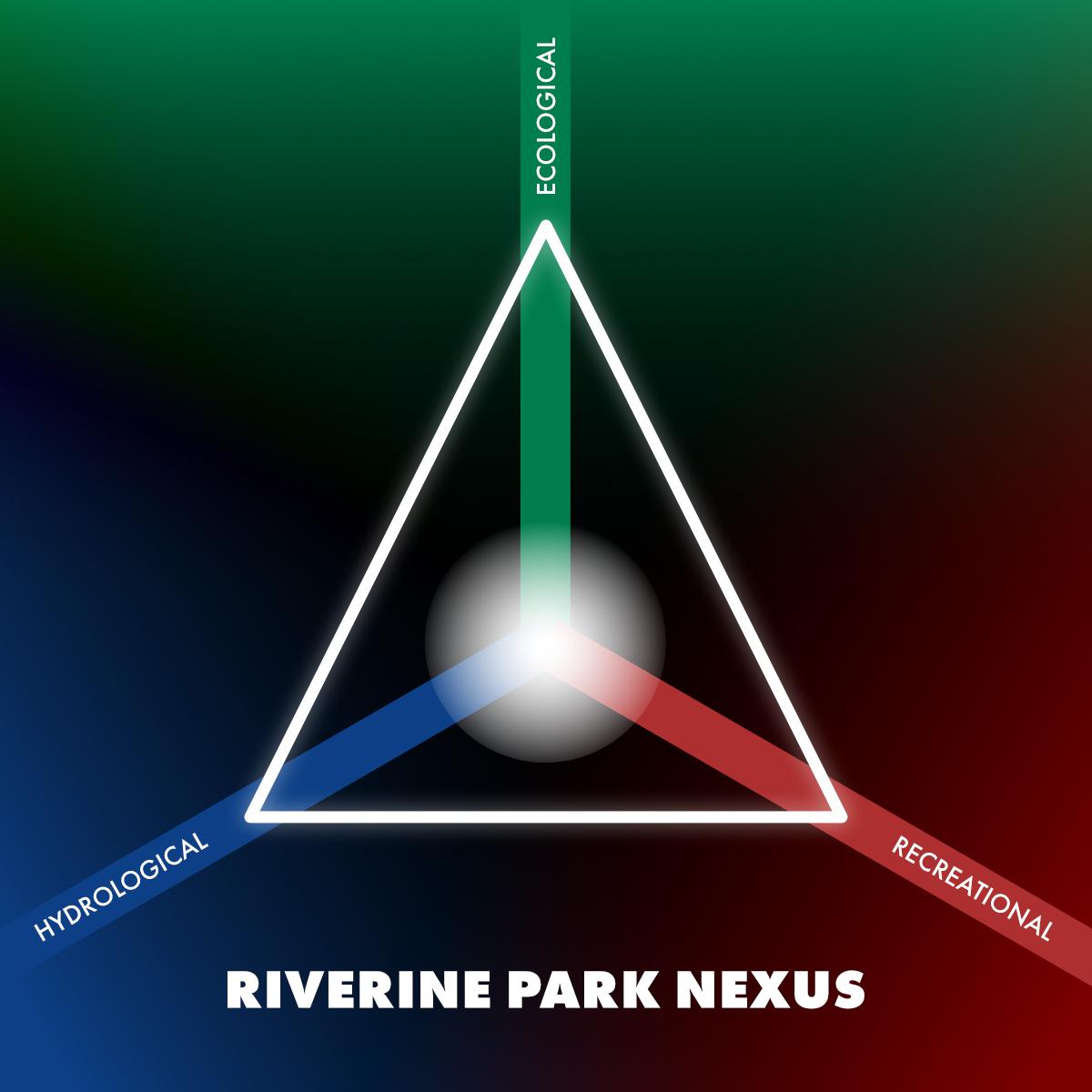
Riverineparksarehybridsocio-ecologicalspacesthatcombine, reconfigure,andmetabolisehuman,nonhuman,andnon-living elementsthroughdesigntosatisfyamultiplicityofhumanneeds. Mydissertationproposesthenovelconceptualframeworkofthe riverineparknexustoexplorethedesignoftheseparks.
Theriverineparknexusreferstoanapproachtowardsdesigning riverineparksthatbalancesrecreational,ecological,and hydrologicalconsiderations:
1.recreational: riverineparksasdesignedtomaximise enjoyableandrestorativeexperiencesastheyareinhabited andusedbyhumanparkusers
2.ecological: riverineparksasdesignedtoaccommodate nonhumaninhabitantsandtomaximisepleasantnonhumanhumaninteractions(‘contactwithnature’)
3.hydrological: riverineparksasfront-linedefencesagainst urbanflooding
TheOlympicParkcollapsesacity/naturedualismingenerative, landscape-scale,andforward-thinkingwaysthroughamore-thanhumandesignapproachthatintegratestherecreational,ecological, andhydrologicalconcernsoftheriverineparknexus.
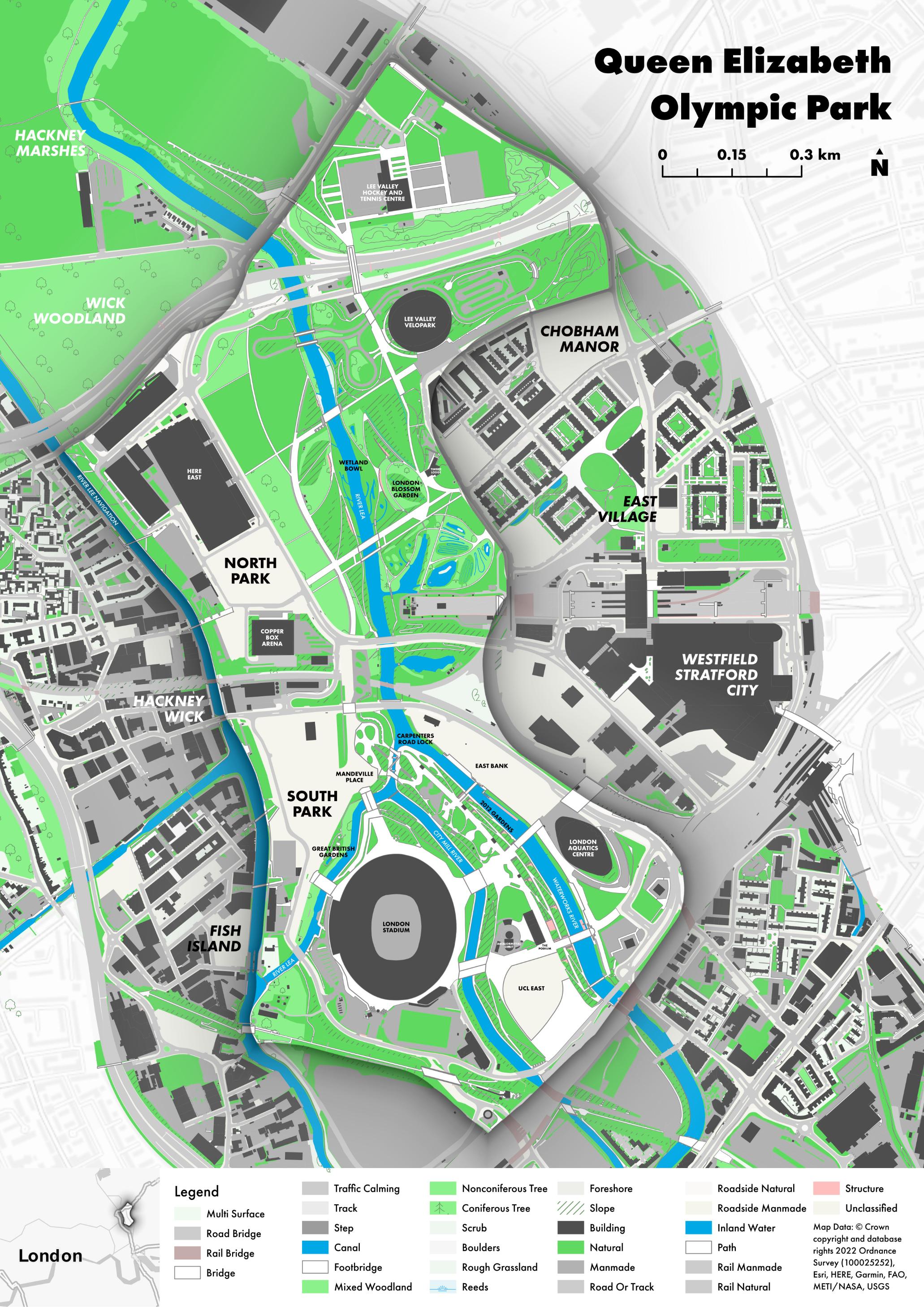
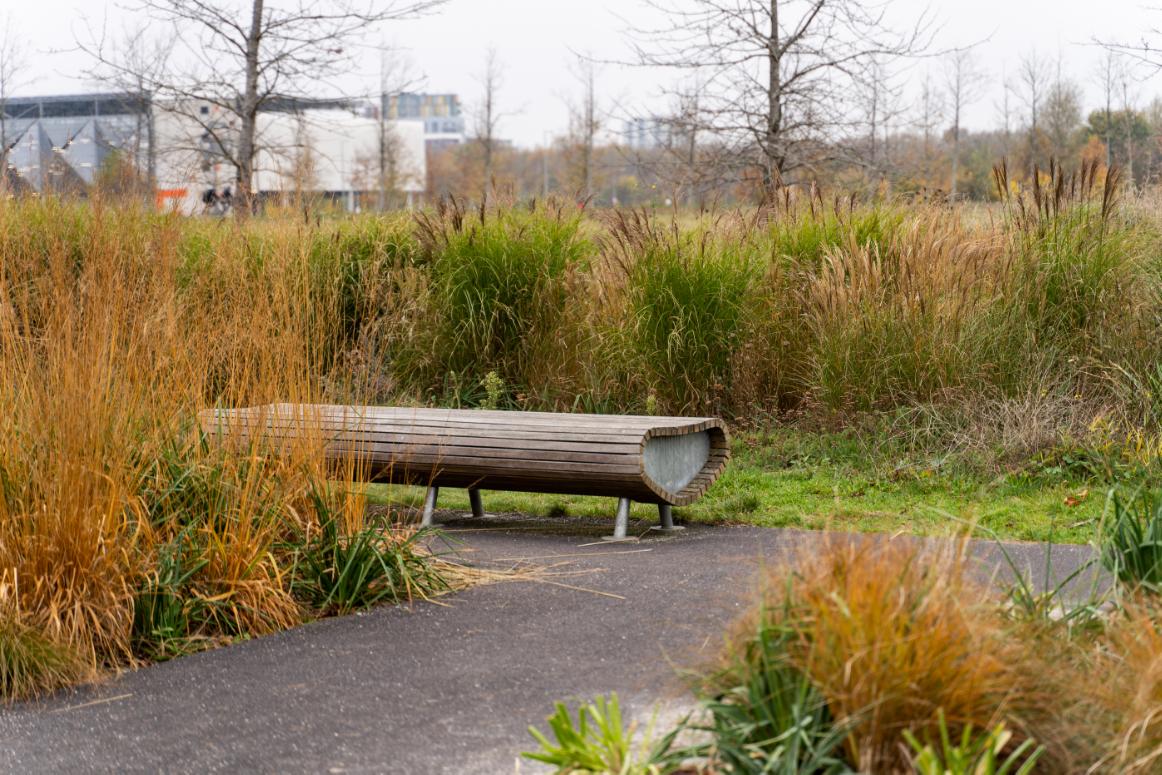

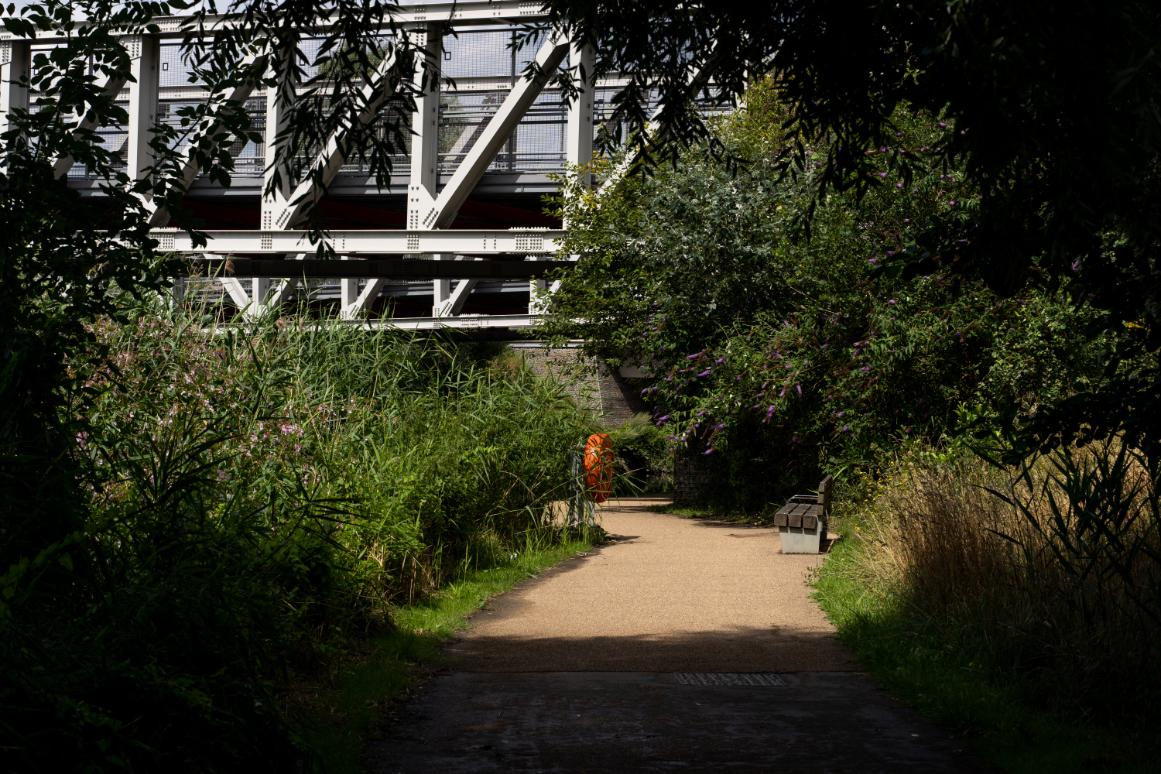
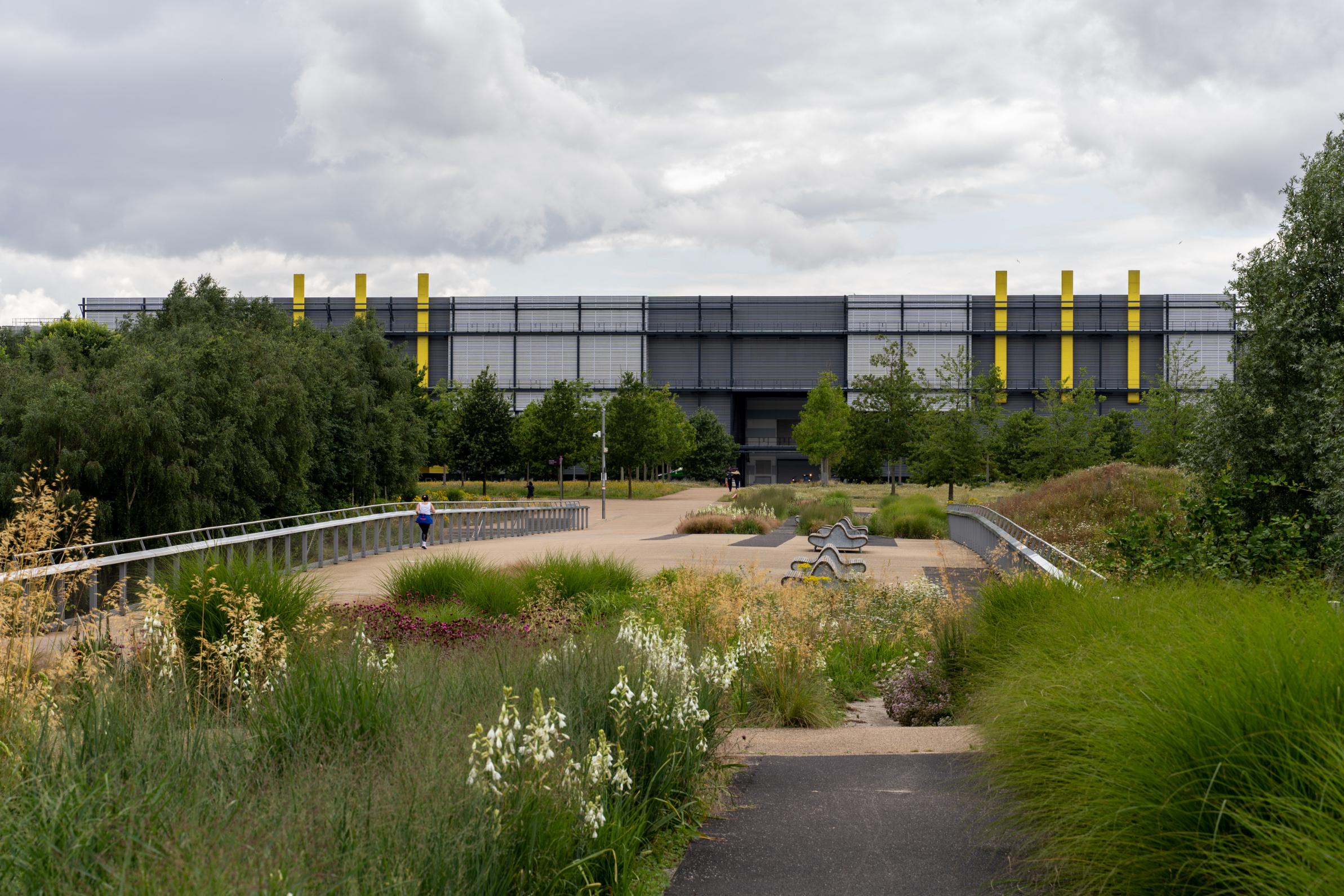
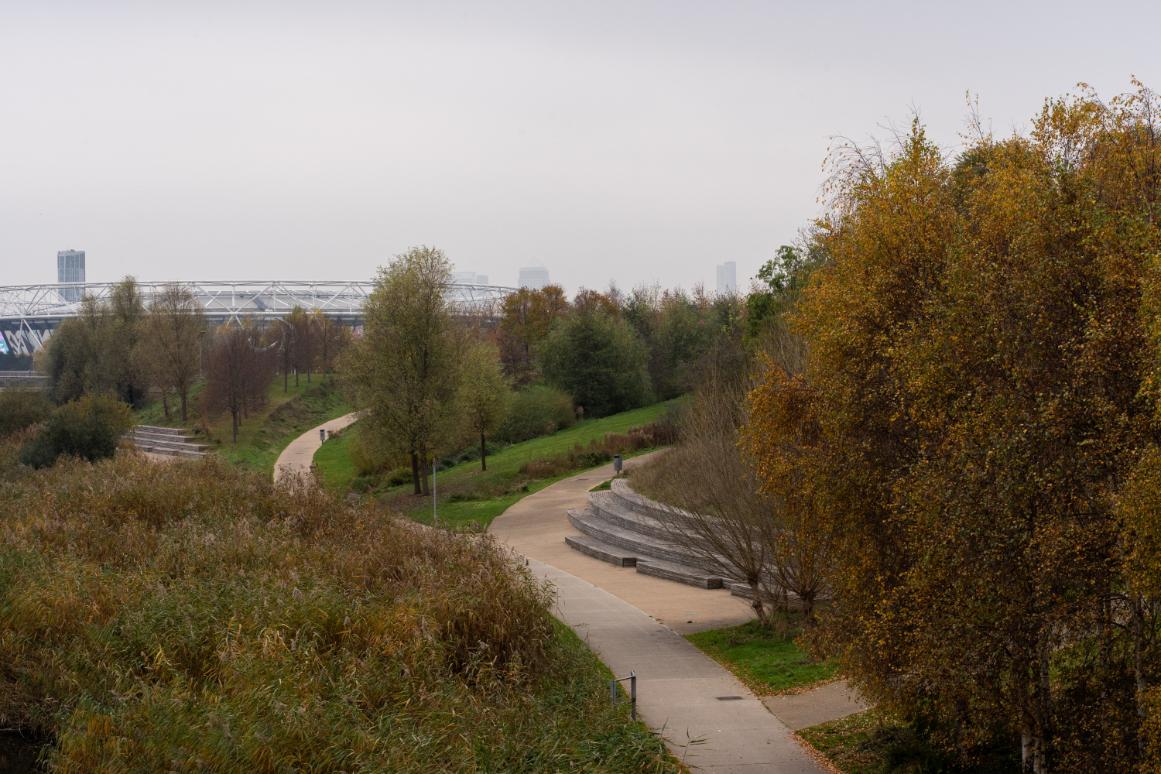
Thecomplexnatureofthespacesandvolumesofthe OlympicPark,consistingofaseriesofzonesandlevels thatrunintoandblurintoeachother,createsaseriesof ‘parkswithinparks’.Eachhaveadifferentfeeland character,accommodatingcontrastingexperiencesand practiceswithinthesingularityoftheOlympicPark.
Opportunitiesforcontactwith‘nature’areembeddedin theecologically-mindfuldesignedspacesoftheOlympic Park.Theseopportunitiesarefrequentlygenerativeof delightfulexperiencesforparkusers,suchasenjoyingthe perfumesofflowers,followingthelifecyclesofswansin thewaterways,andhavingasensethatthereis‘more aroundyou’.Inthisway,parkusers’encounterswiththe OlympicPark,becauseofhowitdeploysecological approachestoriverineparkdesign,aredistinctivelymorethan-human.
Designingriverineparkstohavehighlevelsofhabitat complexity,astheOlympicParkdoes,isaproductive strategyforincreasingopportunitiesforhumansand nonhumanstointeractinriverineparks.
More-than-humanencounterswiththeOlympicParkarealsomorethan-animalandmore-than-plant.Watergainedagencyin participants’encounterswiththeOlympicParkasnonhuman actant.Thisisbecausetheparkwasdesignedtoworkwithwater throughwater-sensitivehydrologicaldesignstrategies.
TheOlympicPark’slandscapedesignmakesspacefortheRiver Lea’sdynamicstooperateandsurface,intriguingparkusersand inspiringasenseofcuriosity.Spotlightingriverdynamicsthrough riverrehabilitationcandeliverbenefitstoparkusersbeyond improvementsinfloodprotectionandhabitatquality.
TheresultisthatwaterintheOlympicParkyieldsarestorativeaffect of‘gettingoutofit’,asenseofimmersionenabledbytheintegration ofwater,city,andparkthroughouttheOlympicPark’slandscape design.
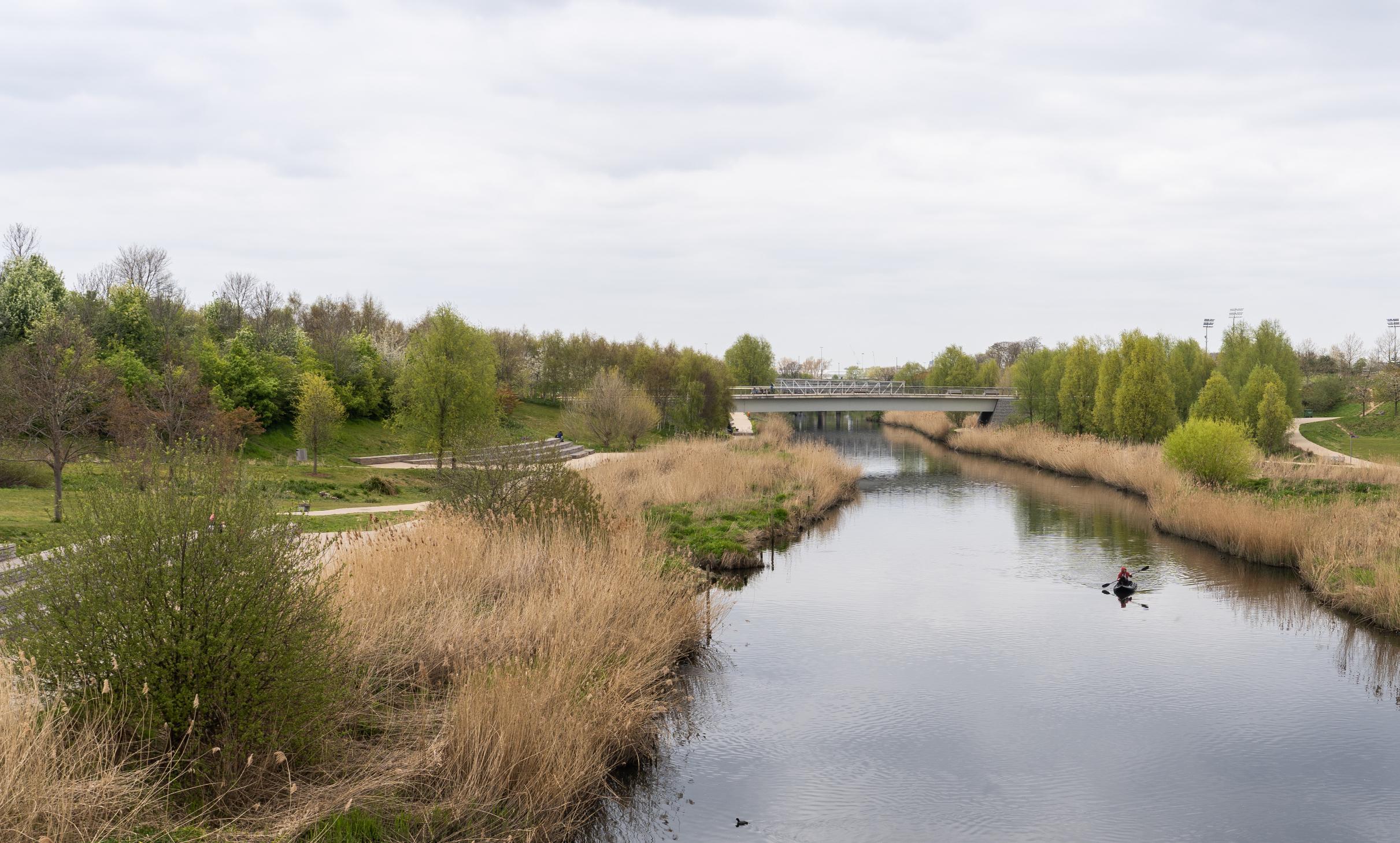

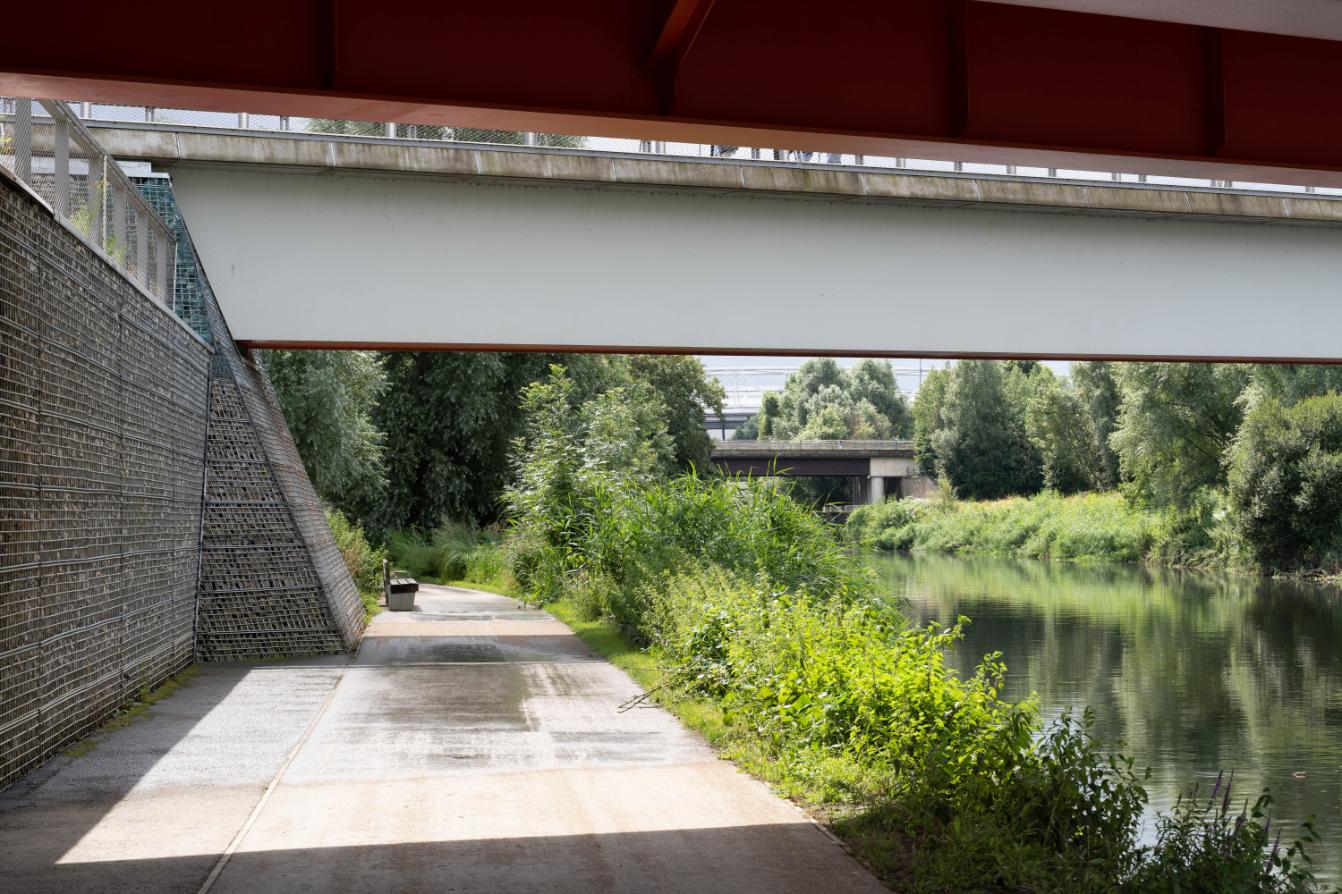

PersonalProject(2022)
Thisprojectproposesastrategyfordesigningtheland-river interfacetospotlightriverdynamics,createspaceforurbannature, andhelppeopleconnectwithurbanstreams.
Stage1
Openinguptheland-waterinterface by breakingdownbarrierstoaccessingand experiencingariverincities.
Wherepossiblebanksshouldbedippeddown tothewater,creatingasubmersibleparkin frontoftheexistingfloodprotectionline.In areaswherespaceislimited,peoplecanbe liftedoverriversusingoverhangingstructures.
Temporaryfloodprotectionelementscanbe usedtobalancefloodprotectionandphysical accesstotheriverbank.
Stage2
Bringingwatertothefore formerlychannelisedanddegradedriversas dynamicandintegraltoanurbanspace.
Abroadrangeofstrategiescanbeappliedto achievethis,frommakingfloodwallsintoeyecatchingsculpturalfeatures,tocreating landscapesthataresubmergedbychanging waterlevelsandreconfiguredbyurban streams’erosionalanddepositionalprocesses.
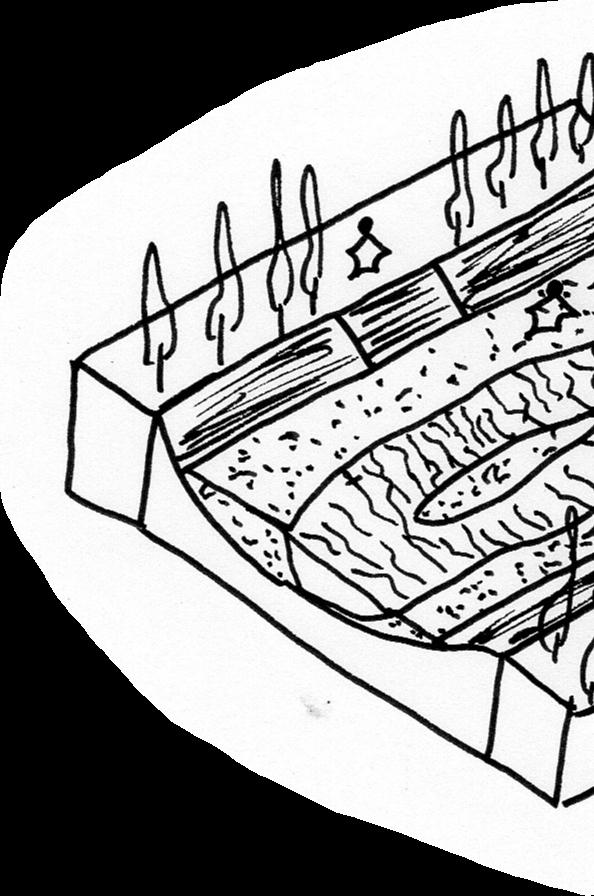
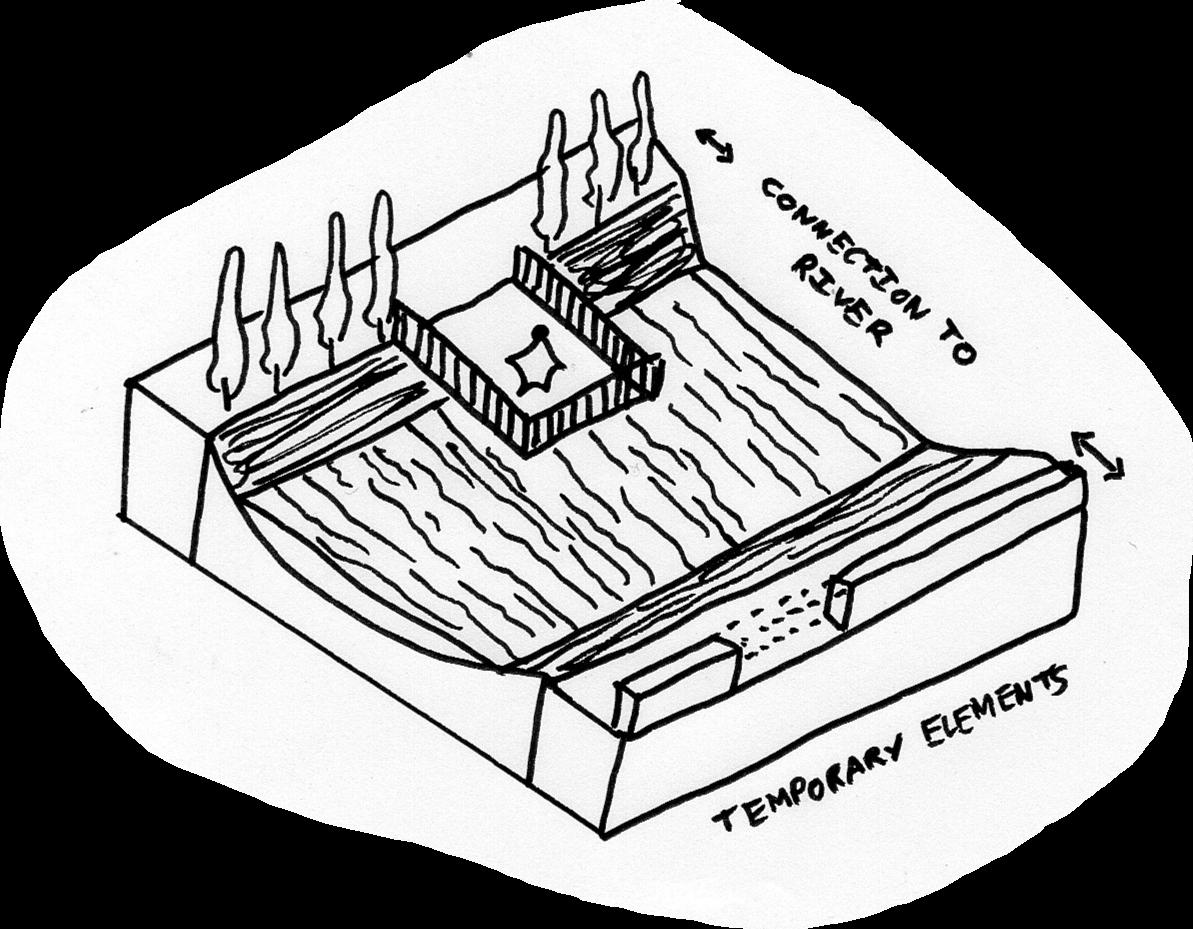
Bringingwatertothefore bytreating formerlychannelisedanddegradedriversas dynamicandintegraltoanurbanspace.
Abroadrangeofstrategiescanbeappliedto achievethis,frommakingfloodwallsintoeyecatchingsculpturalfeatures,tocreating landscapesthataresubmergedbychanging waterlevelsandreconfiguredbyurban streams’erosionalanddepositionalprocesses.
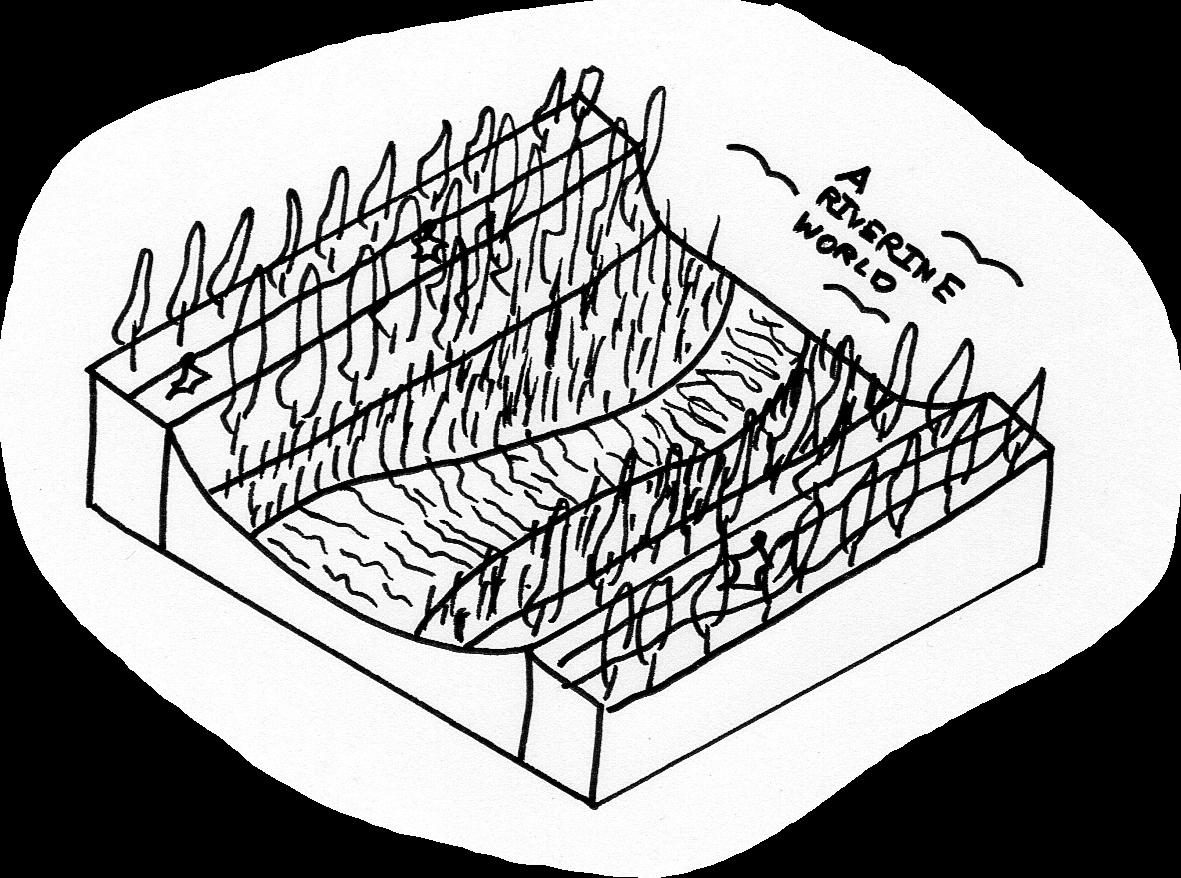

BAGeographyExtendedEssay(2022)
Thisconceptualessayexploresruination, aesthetics,decay,andtherolelandscape architectsplayinshapingexperiencesofurban modernity.Itchartsthegenealogicalcontours of‘urbanwastelands’ascapitalistmodernity’s resourcesanddiscards,unpackingand dramatisingtheaestheticpolitics,tensions,and paradoxesthatunderpinurbanisationand urbanasprocesses.
Theparadoxeslatentinthe‘urbanwastelands’ ofthepost-industrialcitysetupaproblem spaceincontemporarylandscapearchitecture concerningwhetherwecantransformindustrial ruinsand‘wastelands’intoparksinawaythat acknowledgestheirpastusesorwhetherthe ruinfetishisinescapable.
Fullessayatblog.zacharye.com/posts/ molten-wastelands
Urbanwastelandsandtheir‘unscenic aesthetic’unsettlethefamiliarityofurban landscapes.AskeyfeaturesoftheEuroAmericanpost-industrialcity,urban wastelandsbecomewrappedupin utilitarianandnormativediscourses aboutwhatis‘productive’,hasvalue,and belongs/doesnotbelonginthemodern city.
Urbanwastelandsareurbanmodernity’s aesthetic discards and modesofdiscard.
1.Theyaretheliteraldiscardsofurban industries,asunder-determined excessesofcapitalthatcannotbe totallyerasedanddestroyed
2.Thelabelsof‘waste’and‘wasteland’ arenormative,renderingand depictingspacesandmaterialsas uselessandofnovalue,helping capitalismtomaintainamodernmyth ofendlessprogress
3.‘Waste’and‘wasteland’become renderedas‘unrulyothers’that capitalcanneverfullycaptureand absorb,asboundaryobjectsof value-in-waitingandsourcesof untappedpotential
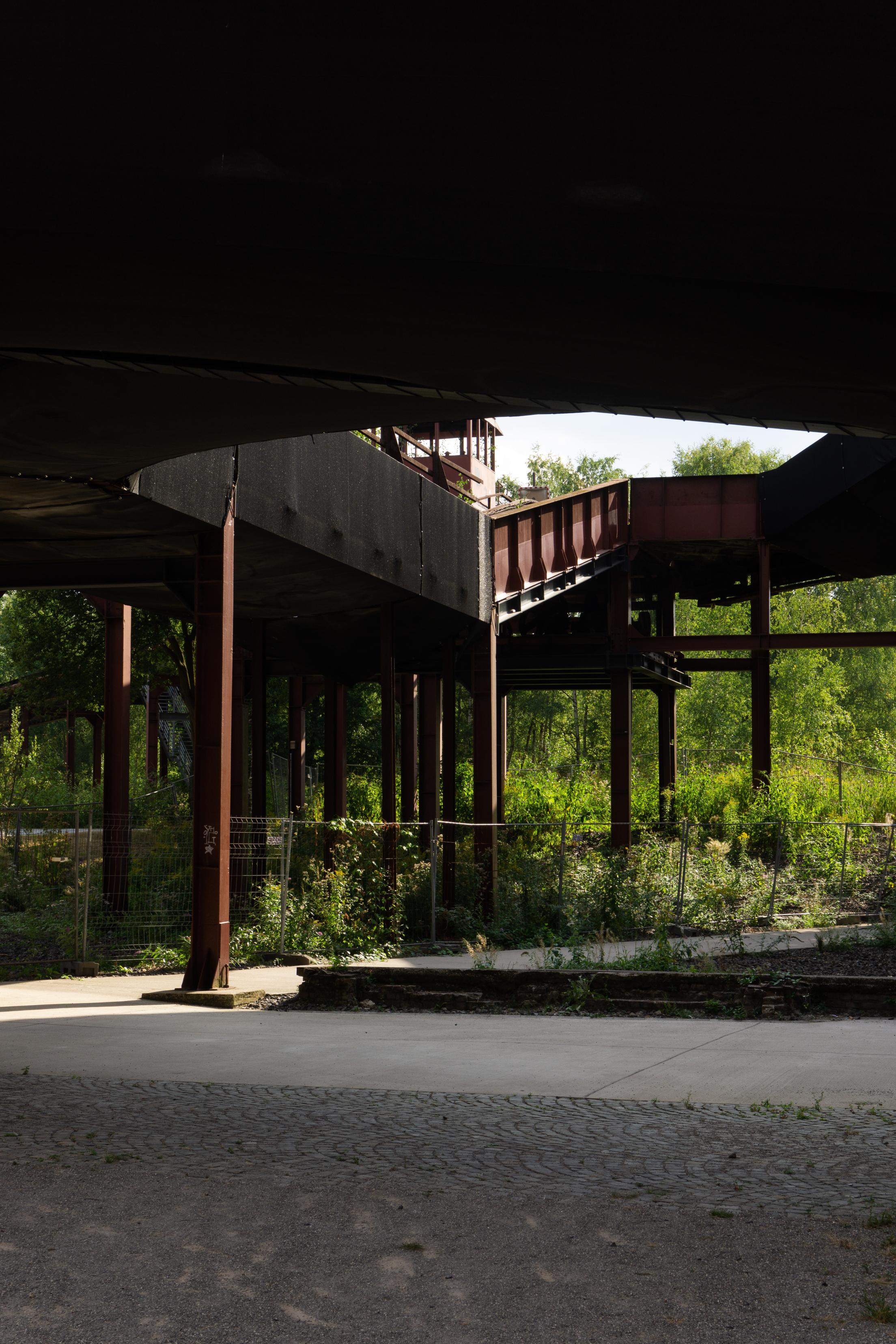
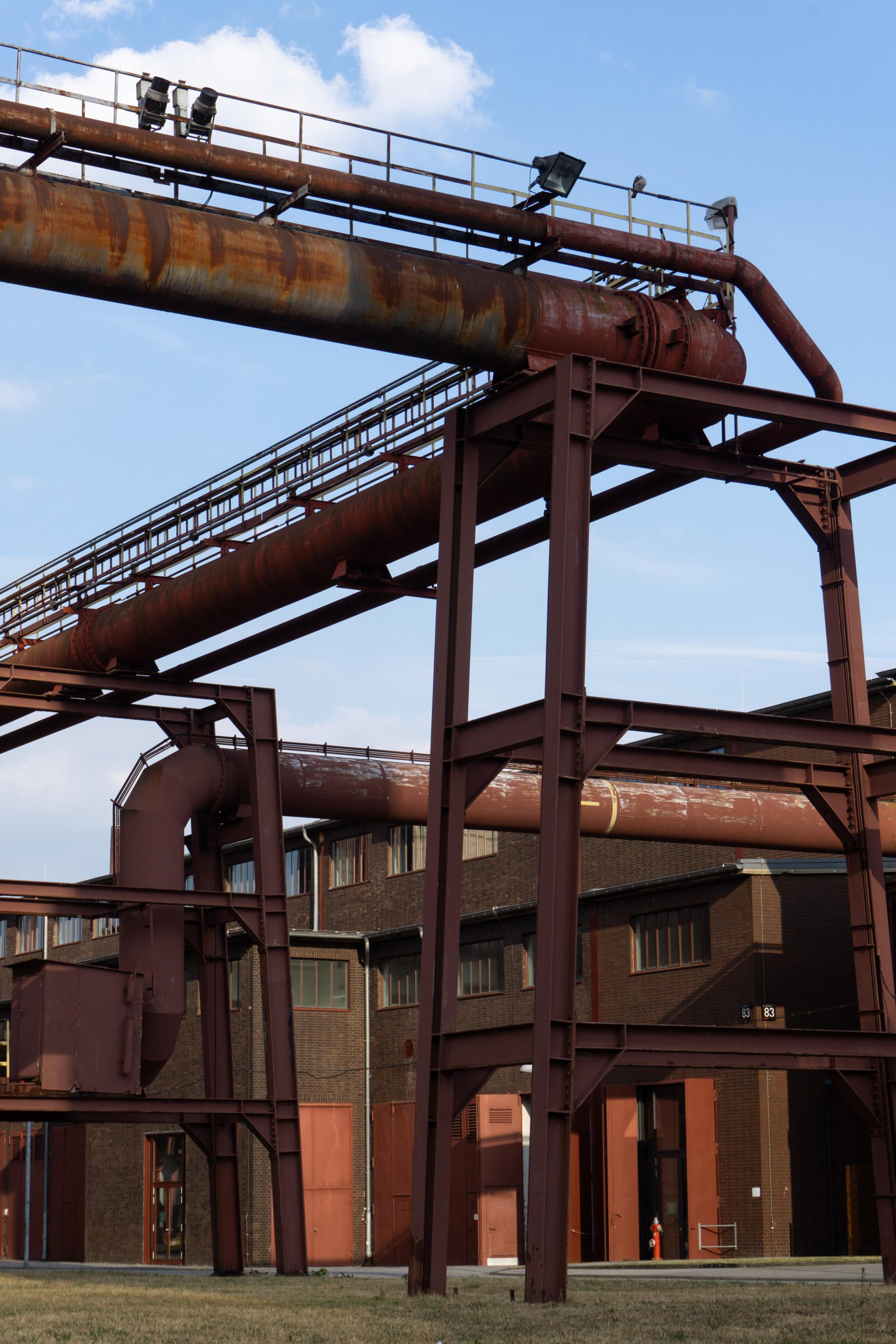
Urbanwastelandsarethediscardsof urbanpasts and theresourcesfor futureurbanplanningand development.
1.Decayandruinationinvertthe orderingofmatterinthespacesof urbanwastelands,astheformand textureofobjectsmeltaway,their assignedfunctionsandmeanings dissolve,andtheboundaries betweenthingsblur
2.Thisproducesamolten, defamiliarizedlandscapethat confoundsurbanspace’s normativeencodingsand becomeschargedwithpossibilities forreinterpretationand(re)use againstthenormativegrainsof ‘waste’,‘uselessness’,and‘void’
3.Urbanpracticesinurban wastelands,likeurban exploration,unfoldwastelandas resourceand siteofcritique againstthenormativeorderingsof urbanspace
4.Urbanwastelandsarealways liminal:freedominurban wastelandsisconditionedbythe ever-presentthreatof developmentanderasure
5.Contemporarylandscape architecturepracticesometimes co-optswastelandasaesthetic resourceinawaythatmoulds wastelandintoaculturalmotifthat destroystheunstructured“magic oftheobsolete”(deSolàMorales,1995,p.123)andthe lifeworldsofthosewhousedthe sitebefore
6.Presentingurbanruinsasa sanitised‘technologicalsublime’ attractspeopledrawntothe ‘spectacle’ofcharismatic industrialforms.Thisculturallyreappropriateswastelandsas objectsofpleasureinawaythat veilsanddiscardsindustrial edifices’pastfunctionsandsocial histories
Amodernculturalimaginationfetishizes abandonment,treatingurbanruinsas aestheticresourcesinawaythathides howcapitalismdiscardspeopleand places,reproducingcapitalism’sdynamic.
1.Anobsessionwiththegrittyaesthetics ofurbanruinsandwastelands (treatingthemasfetishizedaesthetic resources)reproduces,de-politicises, andconsolidateswastelands’ positionsasthediscards,toils,and erasuresofcapitalisturbanmodernity
2.Ruinpornographydepictsand imaginesruinsandurbanwastelands astemplesandaltarsto‘delicious disorder’(Edensor,2005:17-18), layingthemoutaspeople-less, fetishizedobjectsofruinousdelight
Wastelandsaretheparadoxofurban modernity:simultaneouslydiscardsand resources,andthereforelockedintoa liminal“maelstromofperpetual disintegrationandrenewal,ofstruggle andcontradiction,ofambiguityand anguish”(Berman,1983,p.15).
PersonalProject(2022)
Followingonfrom MoltenWastelands, thisprojectexploreswhatitmeansto designwithindustrialruins.Itconsiders somewaysindustrialsiteshavebeen interpretedandtransformedby landscapearchitects.
Sitesvisitedaspartofthisproject combinethreeapproachestodesigning withindustrialruins.Theresulting landscapesare 1.archives offorgotten industrialpasts, 2.sculptureparks of industrialedifices,andstartingpointsfor 3.reimagining aformerindustrialsite assomethingnewanddifferent.

CaseStudiesFeatured
UNESCO-Welterbe Zollverein[Essen, Germany]
LandshaftsparkDuisburgNord[Duisburg,Germany]
QueenElizabethOlympic Park[London,UK]

Industrialruinscanbetransformedinto immersiveoutdoormuseumsofindustrial heritage.Aftercleaningupthesiteto makethevisitorexperiencesafeand accessible,informationalsignage, museums,andaudio/physicaltourscan beoverlaidonthesitetohelpvisitors interpretthespaceasanarchiveof industrialstories,memories,andconflicts. Industrialedificesbecomeexhibitsthat tellstoriesofindustrialpaststovisitors.
Thepresentationofthepastisalways situatedandpartial,whichmeans landscapearchitectsmustaskthe questionofwhatstoriesandmemories areselectedandhowtheyaretold.Are thestoriesofindustrialpastspresentedin thesesitesofmemoryglorifiedor realisticallypresented?
UNESCO-WelterbeZollverein [Essen,Germany]isaformercoalmining industrialcomplexrepurposedasa heritagesitesinceitsclosureinthe1980s. TheRuhrMuseumishousedintheold CoalWashery,tellingthestoryofthe RuhrArea’sindustrialandsocialhistory. TheZollvereinFoundationhassensitively maintainedtheindustrialcomponentsof thesitesinceitsclosure,keepingtheir formsintactsothatvisitorscanseehow theindustrialbuildingsrelatedand workedtogetherwhentheplantwasin operation.
PlanergruppeOberhausenhaveoverlaid ahuman-scaleparklandontopofthe Zollvereinsite,creatingapublicspace thatsuperimposespre-existingindustrial edificesandspontaneousvegetationwith newinterpretivesignageandrecreational infrastructuretoimprovelegibilityand comfortforvisitors.Theresulting complexityoflandscapeinvitesvisitorsto explorethesiteattheirownpaceandto developtheirownperspectivesand interpretationsofthesite’sheritage, industrialecology,andbuildings.
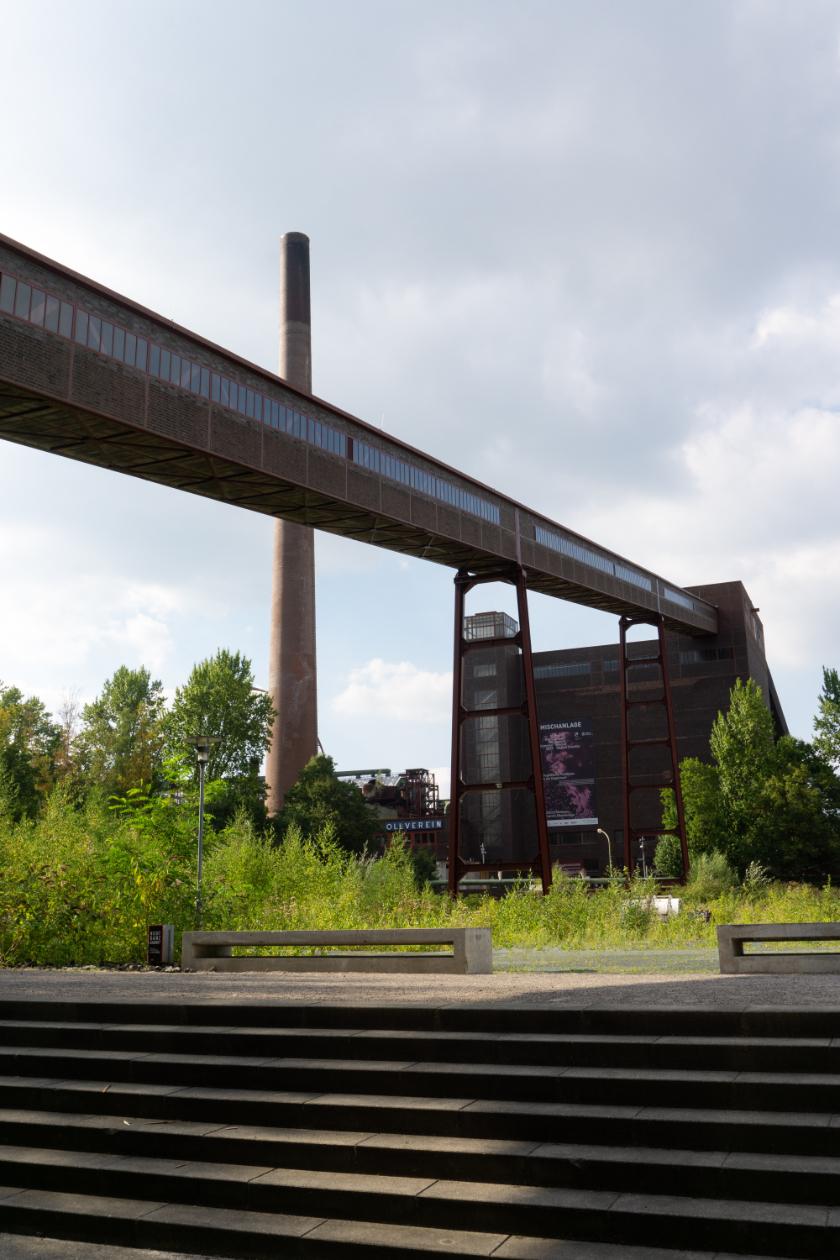

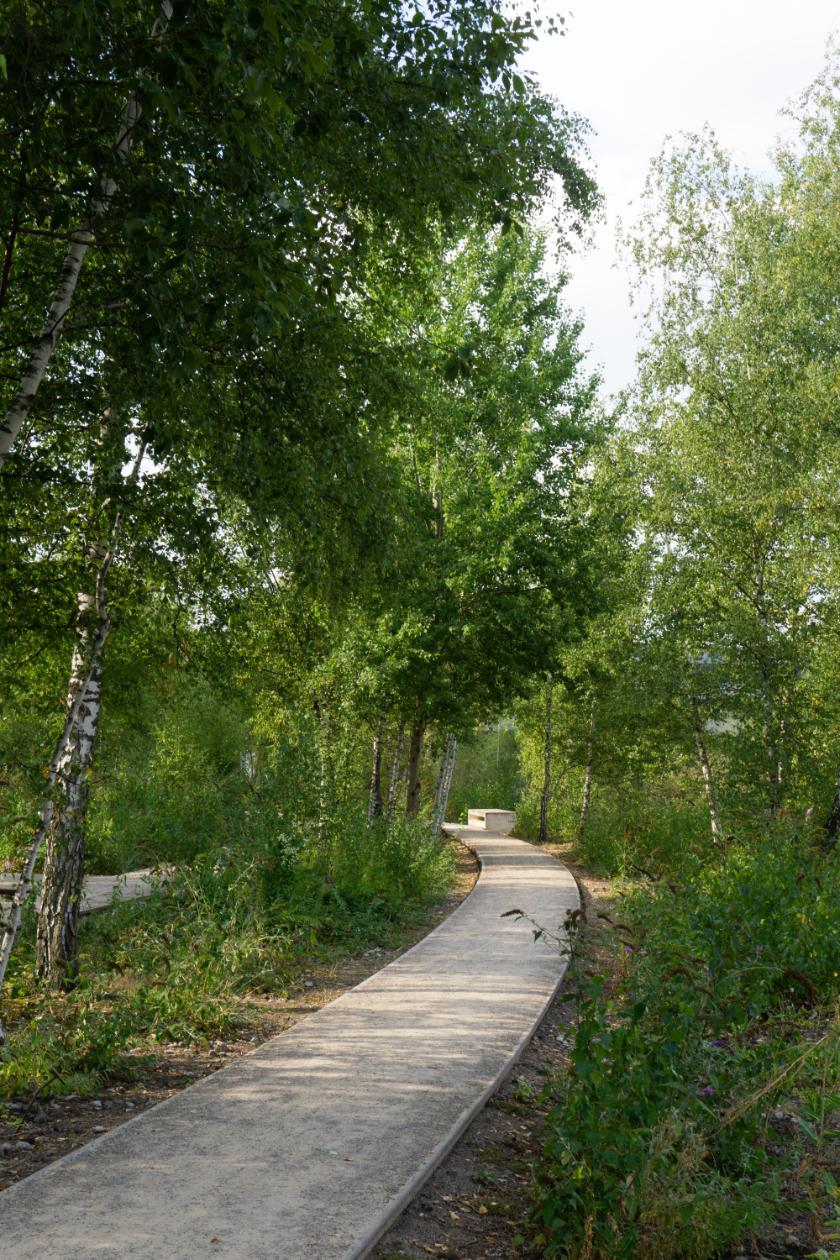
Industrialruinscanalsobetreatedassculptural monumentstoindustrialpasts.Thedecayof industrialruinsovertimemakesthem symbolicallyandmateriallyvague,opento interpretationbyvisitorsassculptures. However,itisimportantnottoobscurethe darkerhistoriesofindustrialsitesaslociof capitalistexploitationwhentreatingthemas sculptures.
Theindustrialsculpturesscatteredthroughout post-industrialparksarecentralcomponentsof an‘industrialsublime’,workingascharismatic aestheticformsthatattractvisitorstothese strangelandscapes.Thegrittyaestheticofthe ‘industrialsublime’hasbecomepopularisedas partofacontemporaryfetishizationof abandonmentamidstthefallof‘mighty’20th CenturyindustrialmodernityinWestern Europe.
Industrialruinscanbetreatedasstartingpoints forreimaginingasiteassomethingnewand different.Theprocessofreimaginingan industrialruinassomethingelseisdiverse, rangingfrommaterialpreservationtomaterial transformation.Theoverallobjectiveissimilar: transformingasitethatwaspreviouslyderelict intosomethingnewandreactivated.
Strategiesofreimaginingasitethrough materialpreservationtransformhulking industrialedificesbyaddingattractionsand programmaticinfrastructuretoanexisting industrialruin.Thisisa functional reimagination ofthesitethatinvitesnewuses ofthespace. LandschaftsparkDuisburg-Nord exemplifiesthisstrategy.
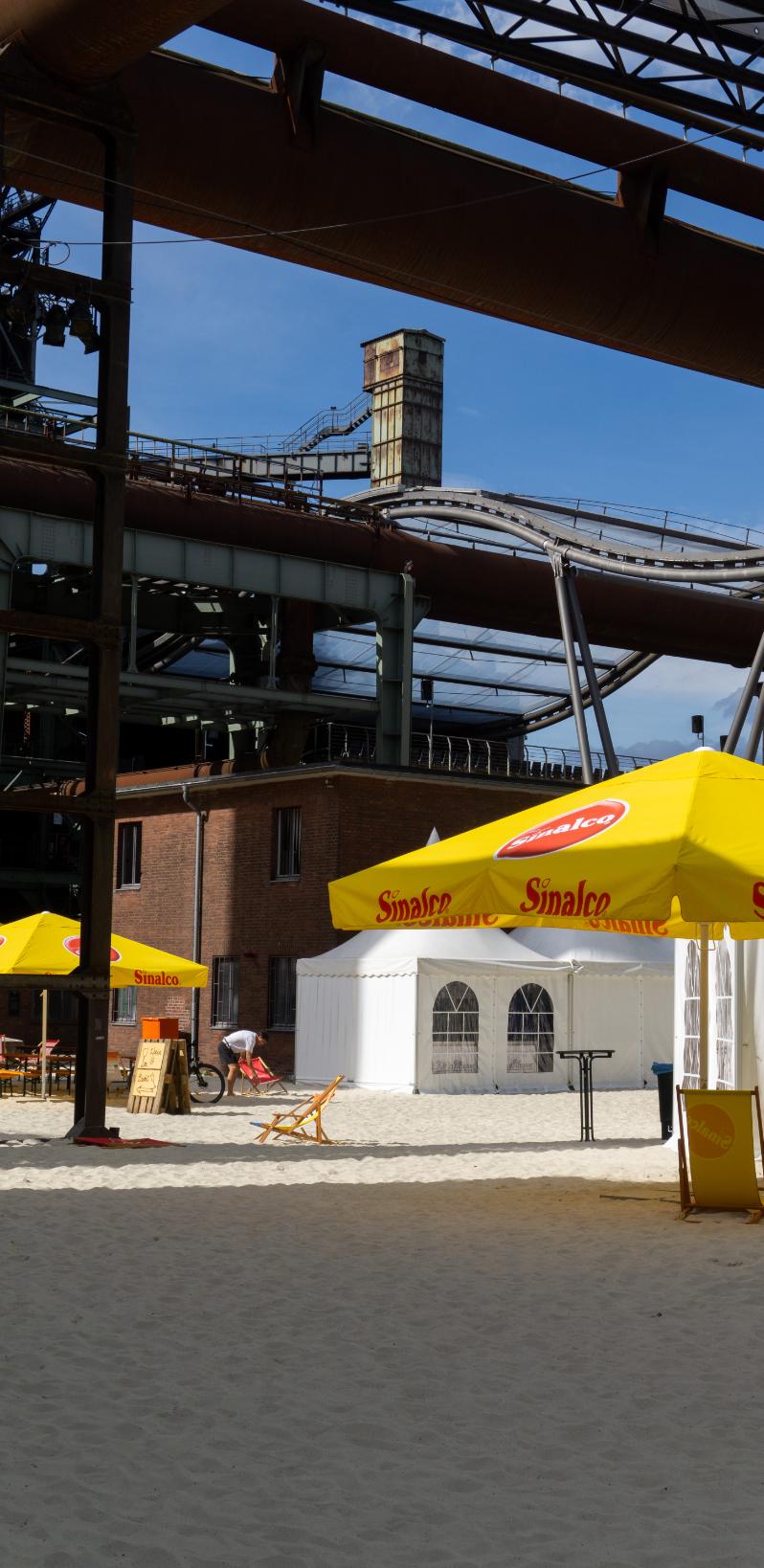
Sitescanalsobemateriallytransformedand completelychanged.Thisisa material reimagination ofthesitewheretheformof thesiteismeltedandrecastinamaterially differentmould.The QueenElizabethOlympic Park,forexample,replacestheprevious industrialcontentsofthesitein-situ,andthe industrialcharacterofthesitebefore redevelopmentisre-expressedincommissioned artworks,materialandplantingpalettes,and therefurbishedcanalsandwaterways.
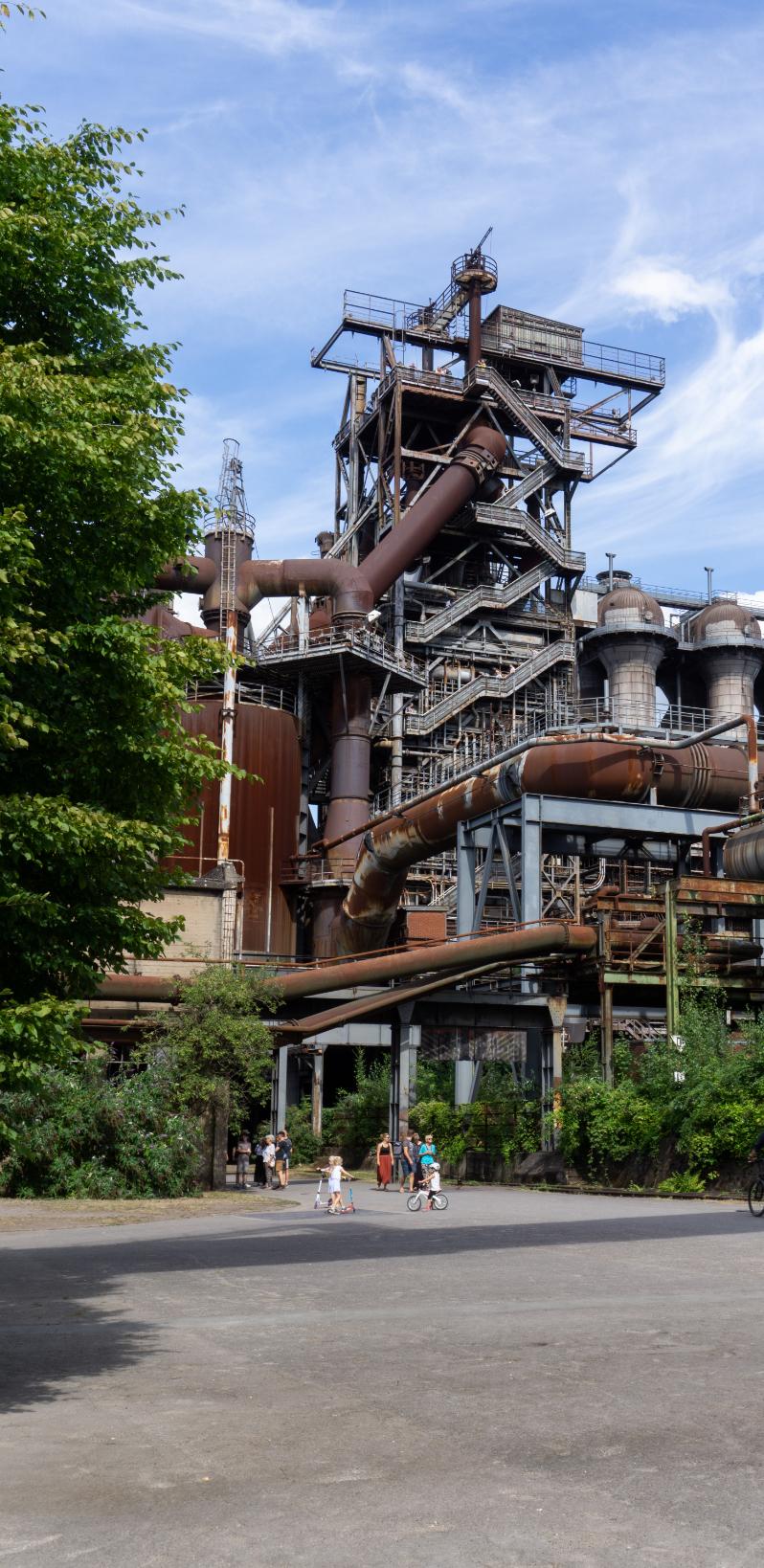
Landschaftspark Duisburg-Nord [Duisburg,Germany]isa parklandcreatedbyLatz+ Partnerin1991onthesite ofacoalandsteel productionplant abandonedin1985.Peter Latzreimaginedthese industrialruinsinaway thatembraces,heals,and workswith,ratherthan rejects,thesite’sindustrial past.Oldstructureshave beenretainedandnew usesfound,spontaneous vegetationandindustrial natureencouraged,and soilremediation undertakentomakethesite safeforrecreational activities.

Manynewuseshavebeen foundforthesite’sderelict industrialruinsasaesthetic backgroundstorecreation: ablastfurnacebecomesa cinemaandurbanbeach,a gasometerisrebornas scubadivingtraining centre,andconcrete bunkersmetamorphosise intorockclimbingwalls andgardens.

Programmaticelementssit amongspontaneous vegetationandsculptural industrialrelics.Theresultis almostpost-apocalyptic: visitorsenterabewildering, vast,andruinedlandscape fullofdecayingindustrial edificesrichinmemory,full ofintriguingdetails,and reclaimedbyplants.

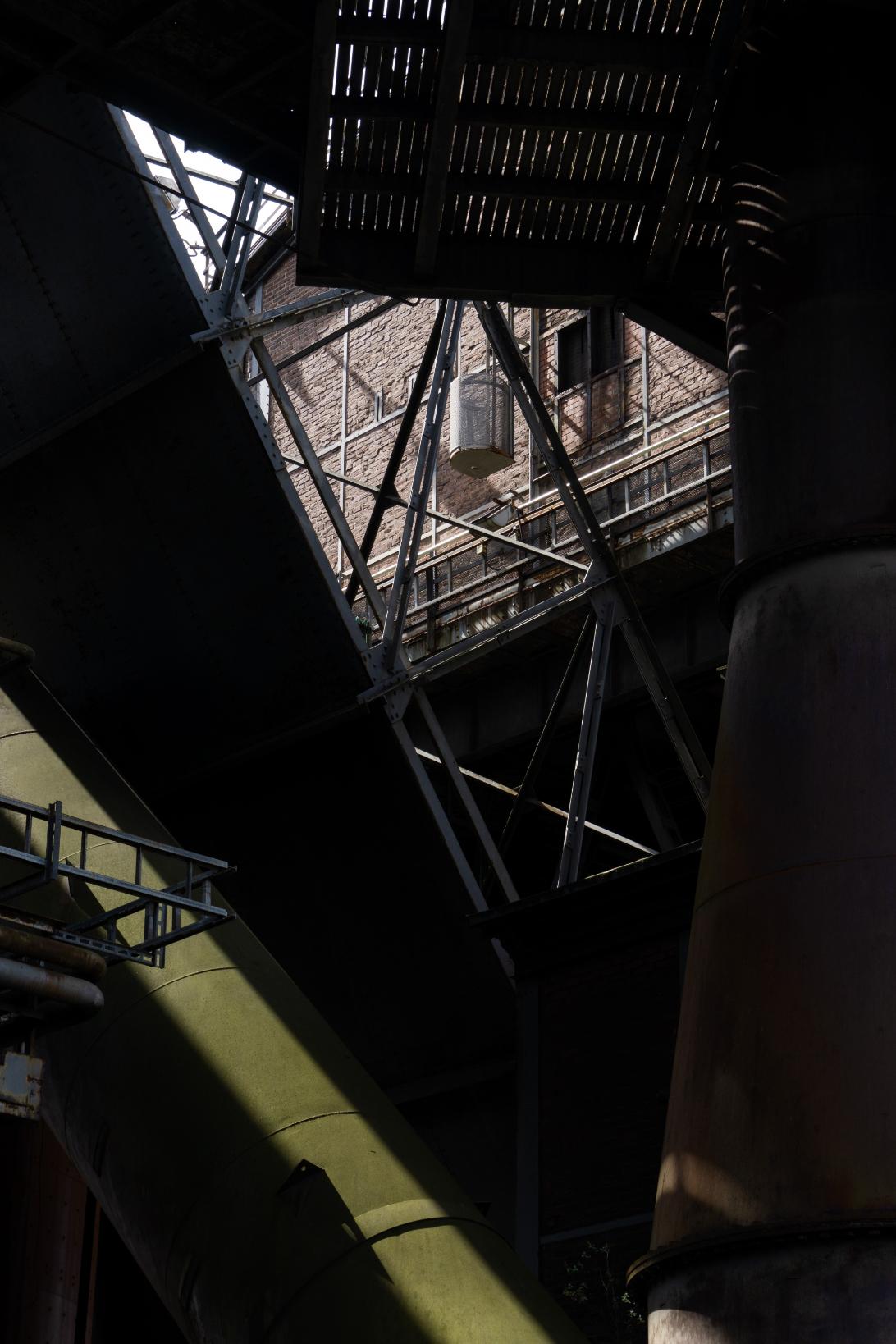
BAGeographyGISResearchProject(2022)

Thisresearchprojectusesnetworkmodellingand geospatialanalyticaltechniquestoexaminetheuneven provisionofgreenspacesintheDenver-Aurora-Lakewood conurbationintheUSA.
ItfoundthatgreenspaceprovisioninDenvercontinuesto behighlystratifiedalongaxesofraceandincome.Low incomeandpredominantlyBlackandLatino neighbourhoodsinAuroraandNorthDenverarepoorly servedbypublicgreenspaces,withlessthan10%of residentialpropertiesabletoaccessaparkwithina10minutewalkofhomeinmanycases.Thisisalegacyof systematicdisinvestmentintheseneighbourhoods.
Ispotlightedthevastinequalitiesingreenspaceprovision inDenverbycomparingacomputationofresidentialpark accessibilityagainstdataonpopulationcharacteristicsand environmentalstressors.
CreatingmoregreenspacesinAuroraandNorthDenver wouldhelptocounteractahistoryofdiscriminatoryurban planningandcreatepositivehealthoutcomes.
Seemoremapsatzacharye.com/access-topublic-green-space-in-denver

OlympiaparkMünchen,Germany(2022)
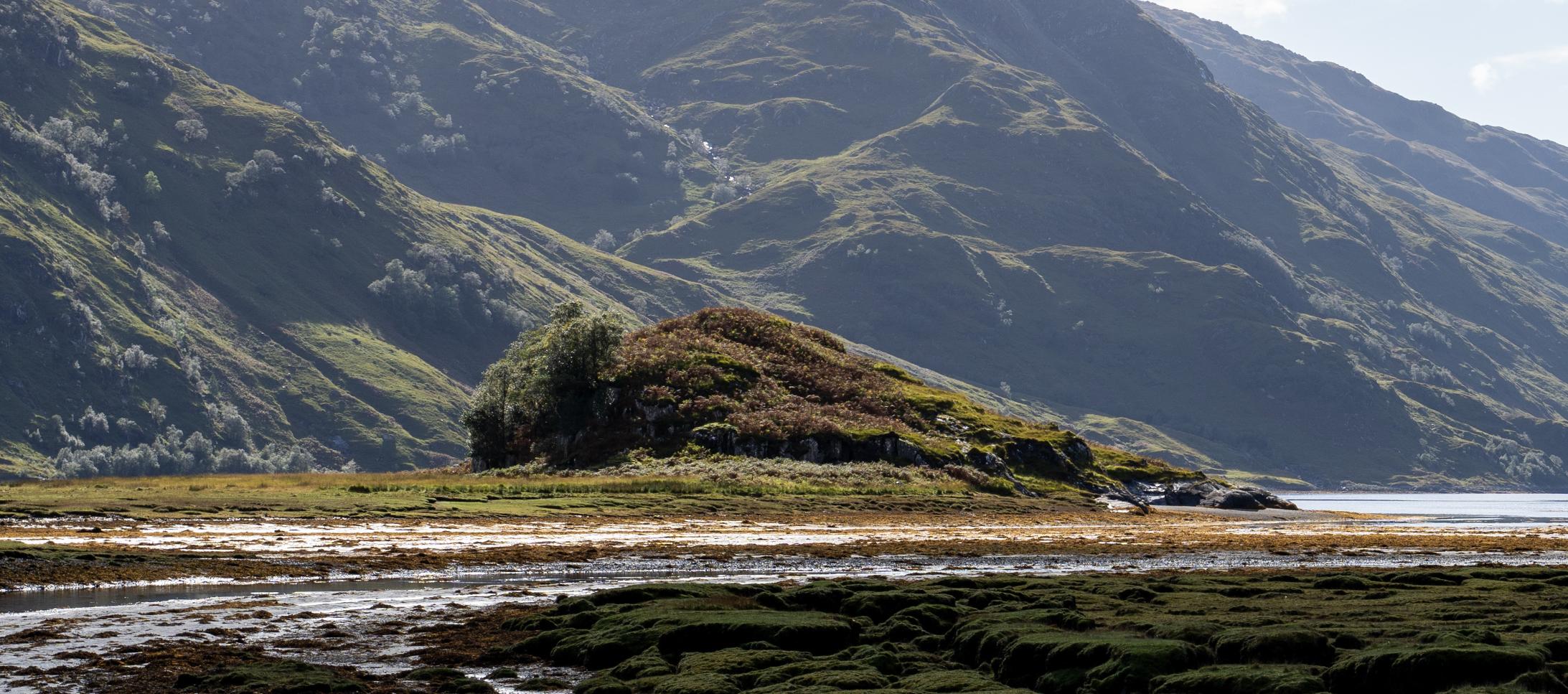
DesignedbyGüntherBehnisch ObservationalPencilSketch
